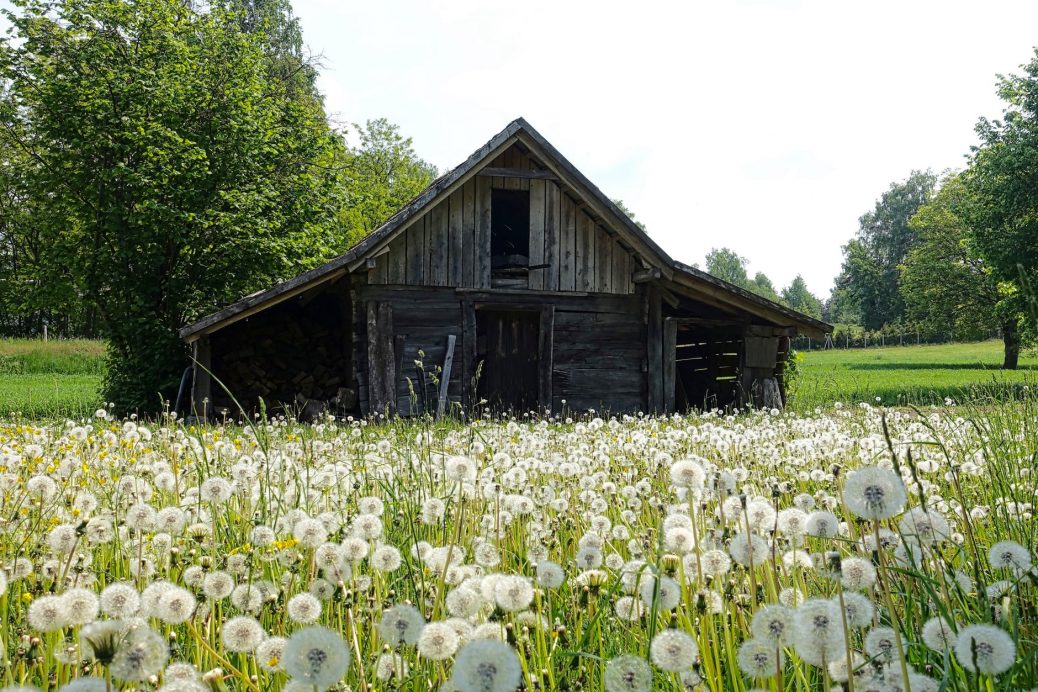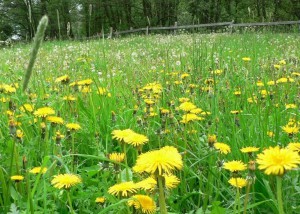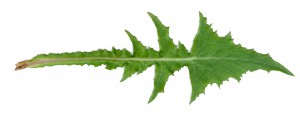By Kristina Seleshanko
Dandelions may be the perfect food — every part of this common weed is edible. They are prolific, easy to identify, and there are no poisonous look-alikes. They are highly nutritious, can be medicinal, and best of all, they are free.
Although it may come as a shock to urban dwellers who’ve grown up thinking dandelions are the enemy of perfect lawns, tidy sidewalks, and weed-free flower beds, dandelions aren’t native to the Americas. They were purposefully brought here by immigrants who knew how valuable the plant is. Today, gourmet grocers and restaurants serve up dandelion greens (but rarely other parts of the plant) and charge a hefty sum. But you can take advantage of this delicious, nutritious food for the mere cost of taking a few minutes to pick and wash it.
Most people recognize the dandelion’s bright, sunny flowers; however, it’s best to learn to identify the plant before it flowers, since that’s when the nutrition-heavy leaves are most palatable.
In sun or shade, look for a rosette of toothed leaves in the early spring. Imitators may have a similar rosette, but their leaves are smooth, not multi-pointed like the true dandelion. If you dig up a rosette, you’ll also find the taproot isn’t a series of thread-sized roots, but that there’s a center root that’s large and fleshy (rather like a parsnip) — how large depends upon the age of the plant, but older dandelions have been known to have roots 18 inches long.
Important Note
Although dandelions can be found almost anywhere, avoid eating those near busy roadsides; these plants soak up chemical fumes from vehicles. In addition, avoid harvesting dandelions from any place pesticides may have been sprayed.
Dandelion roots
Dandelion roots may be treated like parsnips or any other root vegetable, although they may be more bitter, especially if harvested once the plant begins growing stems. The roots have medicinal properties; I use them in a tea to greatly relieve the crankiness of PMS. They are also traditionally used for balancing blood sugar, relieving stomach upset, “clearing out” the kidneys and gallbladders, and reducing inflammation. They are packed with beta-carotene, calcium, vitamins B1, B2, B5, B6, B12, C, E, P, and D, potassium, phosphorus, magnesium, and zinc.
As any organic gardener will tell you, dandelions aren’t that easy to pull up from the ground. I suggest harvesting dandelion roots after a good rain, or after an area has been irrigated. Insert a hand spade, a hand-held dandelion puller, or a long flat screwdriver an inch or so from the center of the dandelion rosette. Gently tug on the stem with the opposite hand until the root comes free. Often it’s impossible to remove all of the root from the ground, but that’s okay. This will ensure a new crop of dandelions for future harvests.
Be sure to scrub the roots well with a vegetable brush before cooking.
Roasted dandelion root: Cut larger dandelion roots, plus other vegetables like carrots, parsnips, and potatoes, into pieces of about the same size. Toss with a little olive oil, season with salt and pepper, and place in a roasting pan. Add a meat (like chicken), if desired; this is a good way to cook a whole meal at once, and the juices from the meat add flavor to the dandelion roots and vegetables. Cook at a temperature and length appropriate for the meat, or, if not using meat, roast them in the oven at 400° F for about 25 to 30 minutes.
Dandelion root “coffee:” Although this is an oft-mentioned “coffee substitute,” it doesn’t really taste like coffee. Still, it’s a soothing, warm drink. To prepare the root, place a wire cooling rack inside a baking tray, then cover the rack with a sheet of parchment paper. Cut the cleaned roots into pieces of about the same size and place on top of the parchment paper. Roast in a 250° F oven for 2 hours, leaving the oven door slightly ajar. When ready to make decaf “dandelion coffee,” grind the roots in a coffee grinder and use like ordinary coffee grounds.
Dandelion root tea: Wash the roots and chop them into pieces of approximately the same size. Dehydrate at 95° F. You may also dry them in the warming drawer of an oven, or in the oven itself, at the lowest temperature setting. (Use the wire cooling rack method described above.) When ready to make tea, grind about 1 tablespoon of root in a coffee grinder until chopped into very small pieces (but not quite pulverized). Place in a tea ball and cover with boiling water. Steep for 10 minutes or so; oversteeping results in a very bitter tea. You can greatly improve the flavor of this tea by filling one side of the tea ball with crushed red raspberry leaves.
The stems of dandelions are edible and add bitterness to salads or pasta dishes. Break open a dandelion stem and apply the sap to scrapes and cuts for faster healing.
Dandelion leaves and stems
Dandelion leaves are a powerhouse for vitamins A, B, C, and K, and are also a good source of potassium, phosphorus, magnesium, calcium, iron, zinc, carotene, and fiber. Some people insist they are too bitter to eat… but they should be no more bitter than expensive bitter lettuces — often less so — if they are harvested correctly.
For the best, least-bitter harvest, pick before stems and flowers begin appearing on the plant. If you are too late, let the plant finish flowering, then cut the entire plant off at soil level; harvest the new greens before stems appear. The leaves will be only slightly more bitter than if you’d harvested before stems appeared. For even better flavor (but less nutrients), cover the plant with a cardboard box or a pot to blanch the leaves for about two weeks.
Do be sure to wash dandelion leaves very well. To do so, place the leaves in a colander. Toss under cool, running water for at least one minute. Allow to drip dry, or press gently to remove excess moisture. Repeat. Soaking bitter leaves in salt water, then rinsing very well, will improve their flavor; otherwise, don’t soak, or you’ll lose too much flavor.
Dandelion leaf sauté: In a small bowl, combine about 1 tablespoon oil, 4 sliced or minced garlic cloves, and ¼ teaspoon salt. Set aside for 10 minutes. Preheat a skillet over medium heat and add the oil mixture. Sauté the garlic until just golden, then add the dandelion leaves and a little pepper. Sauté just until the greens are wilted and bright green. Remove from the skillet and serve right away. Variation: Cook some bacon and leave the drippings in the pan; when the leaves turn bright, add the cooked, crumbled bacon.
Dandelion leaf salad: Add the washed greens to any salad or make them the main attraction. Try a vinegar- or lemon juice-based dressing. Variation: Wash the leaves in salted water, dry, and set aside. Fry 3 slices of bacon; drain on paper towels. In the bacon drippings, add equal amounts of water, apple cider vinegar, and sugar. Stir until sugar dissolves. Place the washed leaves in a large bowl; crumble the bacon over them, then toss with the apple cider vinegar dressing.
Dandelion leaf tea: Primarily used as a medicinal for stomach problems, dandelion leaf tea is easy to make. Dry the leaves by any method (ideally using a temperature of 95° F). Make the tea by crumbling the leaves into a tea ball and steeping 10 to 15 minutes.
Cooked greens: Wash leaves, but don’t pat dry. Sprinkle with salt. Place in a pot, cover with a lid, and cook until just tender.
Dandelion leaf pot herb: Fresh or dried dandelion leaves may be added to soups or stews. Some people use older, more bitter leaves, using just a handful or less, and find that much of the bitterness is lost when combined in a dish this way.
Dandelion bread: Place 1 lb. of dandelion leaves in a pot and cover with water. Add a little salt and bring to a boil. Drain and chop. Stir in 2 cloves of garlic (minced), ¼ cup olive oil, a little pepper, and a handful or two of freshly grated Parmesan or mozzarella cheese. Mix well. In a separate bowl, stir together 4 cups lukewarm water, 6 teaspoons salt, and 3 tablespoons yeast. In a few minutes, after the mixture turns foamy, stir in 3 cups of all-purpose flour (or 2 cups all-purpose flour and 1 cup whole wheat flour). Roll out to about ¼-inch thick and spread the dandelion leaf mixture over the dough. Roll the dough into a cylinder. Brush the top of the bread with a little olive oil flavored with a minced garlic clove. With a knife, cut shallow slits across the top of the bread. Allow to rise in a warm location for 20 minutes. Bake in a preheated 350° F oven until golden, about 20 minutes.
Dandelion leaf pesto: Wash about 12 oz. of dandelion leaves. Place a third of them in a food processor or blender; add 1 cup olive oil and chop. Add another third and chop; then add the last third and chop. Add 4 garlic cloves, 6 tablespoons of toasted pine nuts, about 1½ teaspoons of coarse salt, and 2½ oz. of fresh Parmesan cheese and purée. If the mixture seems too thick, add more olive oil, a little bit at a time. Use the pesto just like basil pesto; it’s especially good with pasta.
Cream of dandelion leaf soup: Melt 1 tablespoon of butter in a large pot. Add about 6 cups dandelion greens, 1 carrot (sliced thin), and 2 large leeks (light parts sliced thin; dark parts reserved for another dish). Sauté for 15 minutes. Add 4 cups vegetable or chicken stock and simmer 15 minutes. Gradually whisk in 2½ cups milk; cook and stir often until cooked to the desired thickened. Purée with a blender or food processor and season with salt and pepper. If desired, stir in a tablespoon of Dijon mustard.
Other ideas: Use dandelion greens to replace any green (such as spinach, collards, or chard) in your favorite recipes such as omelettes, hashes, quiche, lasagna, spaghetti, casseroles, stuffing, homemade spinach noodles, cooked beans, or on top of pizza.
The unique characteristics of dandelion leaves are evident in this example.
Dandelion flowers
The flowers of dandelions have a very mild, vaguely sweet flavor. They are supposed to be a superb source of lecithin — which is believed to maintain brain function and may help slow or stop Alzheimer’s disease. Lecithin is good for the liver. The flowers are also a good source of vitamins A, B, and C, beta-carotene, iron, zinc, and potassium.
Be sure to wash flowers well under running water. Pat dry. To remove the petals from the sepals (recommended for most recipes), grasp the flower in one hand and pinch firmly where the petals meet the green sepals. Shake and the petals will fall out.
Dandelion flower salad: Add flowers to green salads. Some prefer to remove all the green parts, putting only the petals in the salad.
Dandelion vinegar: Chop dandelion flowers and stuff into a glass jar with a lid. Pour vinegar over the dandelions; I like apple cider vinegar, but you can also use white vinegar. Seal and shake. Store in a cool, dark location for 6 weeks before straining and using.
Fried dandelion flowers: Mix together 2 tablespoons of cornmeal, seasoned with salt and pepper, plus a pinch of oregano and thyme. Beat an egg and dip the flowers, one at a time, in it. Then roll the flowers in the cornmeal mixture. Fry in a pan with a little heated oil.
Dandelion flower cookies: Add about ½ cup dandelion petals (green parts removed) to your favorite oatmeal cookie recipe.
Dandelion flower muffins: Add about a ½ cup of petals (green parts removed) to your favorite basic or banana muffin recipe.
Dandelion flower jelly: This honey-like jelly is well worth the effort. Dump 4 cups dandelion petals (green parts removed) into a stainless steel pot. Add 8 cups of water. Boil for 10 minutes. Strain with a fine strainer and discard the petals. Clean the strainer and place a coffee filter inside it, then strain the liquid again. In a clean pot, pour 3 cups of the strained liquid. (Reserve the remaining liquid for a second batch, or refrigerate it and add it to tea.) Add 2 tablespoons lemon juice, ½ teaspoon pure vanilla extract, and 6 tablespoons powdered pectin. Bring to a full rolling boil that can’t be stirred down with a spoon. Add 4 cups sugar and stir to dissolve. Bring to a full boil, stirring constantly; boil hard for 1 minute. In the meantime, sterilize some jelly jars by boiling them in a water bath canner for 10 minutes. Ladle the dandelion petal liquid into sterile jelly jars, leaving ¼ inch headspace. Process in a boiling water canner for 10 minutes.
Dandelion flower syrup: Cook and strain 1 quart of flowers (green parts removed), just as if making dandelion flower jelly. Add 4 cups of granulated sugar. If desired, add a chopped orange or lemon half (“meat” and peel). Heat, stirring once in a while, until thick and syrupy; it will take a few hours. Process in a water bath canner for 10 minutes.
Dandelion flower tea: Place fresh or dried flowers into a tea ball, cover with boiling water, and steep 10 to 15 minutes. Many sources recommend removing all the green parts of the flower before making this tea, but I find this results in an almost tasteless tea. I prefer to leave the green parts of the flower intact.
Tip: When dehydrating dandelion flowers, it’s important to pick just-opened blooms. If the flowers are older, they may explode into a white puff of seeds while being dried.
Pickled dandelion buds: Gather the buds of dandelions, leaving the stems behind. Place in a pot, cover with water, and bring to a boil. Boil for 5 minutes. Sterilize some canning jars by boiling them in a water bath canner for 10 minutes. In a saucepan, combine 1 cup white vinegar, ¼ cup (packed) brown sugar, 1 cup water, 1 teaspoon salt, 2 tablespoons dill seed, 1 garlic clove (minced), and a pinch of ground cloves; boil for 10 minutes. Pack the dandelion buds in the sterile canning jars and pour the hot vinegar mixture over them. Leave ¼ inch headspace. Place lids on jars and allow to cool. Refrigerate and use within a few weeks.
Other ideas: Add dandelion flower petals to omelettes, pancakes, waffles, cornbread, bread, cake, iced tea, or lemonade.




This is an awesome article! Love it. I have been using leaves in my salads all spring.
My Mother simmered the buds in a bit of water – changing the water 3 times during simmering.
Then she ate them with a bit of butter and vinegar. She grew up in SW Minnesota so anything green and edible in the spring was a luxury.
Carol in Eastern Oregon
I’m from Lancaster, Pa. growing up in the country. I love this reciepe because of the sweet, sour benefit with the dandelions we picked. It’s simple with 1doz. Hard boiled eggs, a plastic Groc. Bag full of leaves, 1bl. Bacon fryed and crumbled, 1 Cup Sugar, chopped Onion and Garlic to your taste. After cleaning the leaves, put them in a large pot with water half way up into the leaves, add 16oz. Cider Vinegar, chopped bacon, chopped eggs, and sugar. Just bring to a boil and simmer until leaves are soft. If too strong, add more sugar to your taste. Or more Cider vinegar to your taste. It is a different type of soup with aquired taste, but the Omish next to me gave it to me and I had a tadte for it.